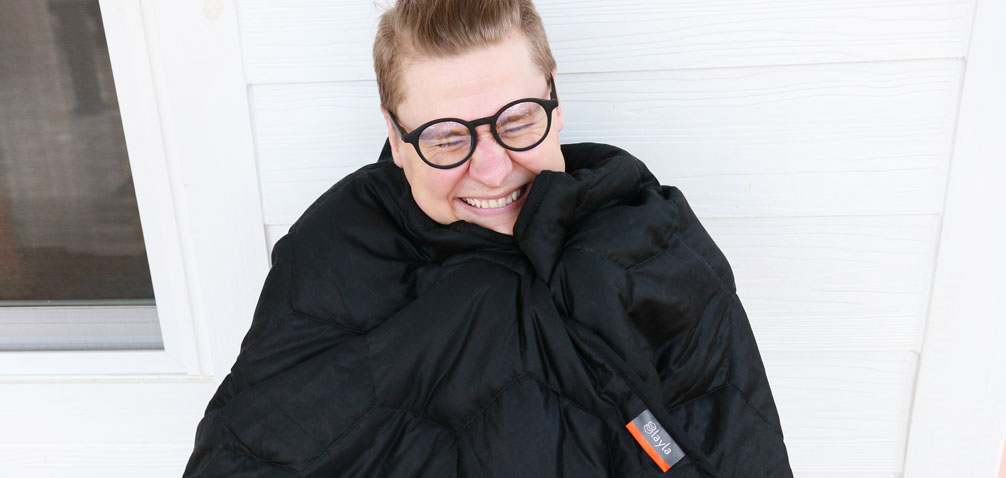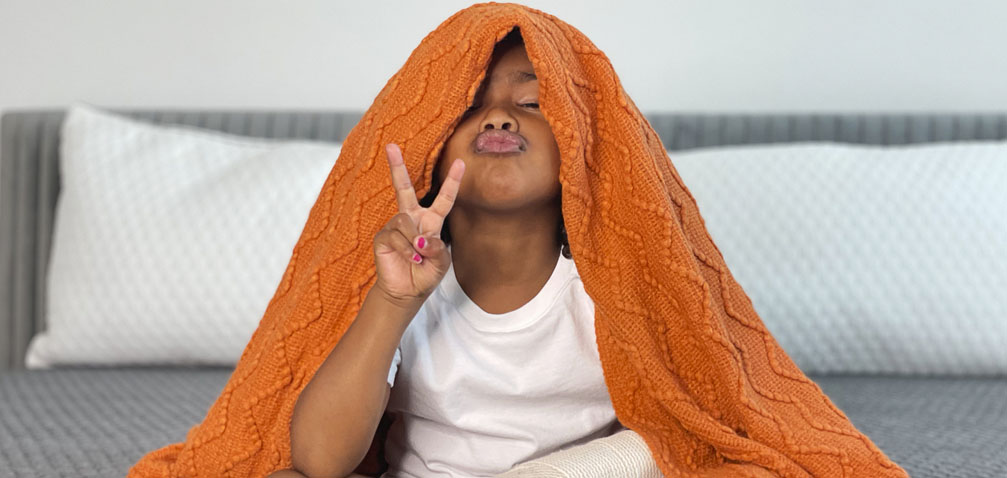You’ve probably heard more about weighted blankets in recent years. They’ve been around with therapeutic uses for a while, but they’re catching on for everyday people.
Weighted blankets can soothe anxiety, quiet your mind, and provide Deep Touch Therapy all over.
More importantly, you are probably wondering how heavy should a weighted blanket be? The answer is simple and complex at the same time (kind of like a riddle).
Don’t worry, we’re here to break it all down for you. Let’s look at how to determine the best weighted blanket weight for your needs and when you know it’s time to buy one. In this guide, you’ll find our weighted blanket weight chart, along with additional information on who can benefit from weighted blankets, whether they’re safe for children, and more.
- Where Do Weighted Blankets Get Their Weight?
- Who Can Benefit from Weighted Blankets?
- Are Weighted Blankets Safe for Kids?
- How Heavy Should a Weighted Blanket Be?
- What If I Fall Between Two Weight Recommendations?
- Is Height a Factor When Choosing a Weighted Blanket?
- Choosing Layla Weighted Blankets
- Wrapping Up: How Heavy Should a Weighted Blanket Be?
Where Do Weighted Blankets Get Their Weight?
When you look at a weighted blanket chart, you’ll notice weighted blankets can come in a wide range of weights, such as 10 pounds, 15 pounds, and 20 pounds. So, where do weighted blankets get their weight? Weighted blankets can be made out of a wide range of materials, including:
- Glass beads
- Plastic pellets
- Rocks
- Sand
- Organic materials
- Steel beads
In order to make the blanket, manufacturers will add the appropriate amount of filling to ensure their weighted blankets are at the right weight. When buying a weighted blanket, make sure to look at the materials and quality of the blanket to ensure you get one that’s durable, comfortable, and rocks you to sleep.
Who Can Benefit from Weighted Blankets?
While scientific research is somewhat scarce, there are plenty of benefits that come with weighted blankets. However, the limited studies that have taken place are very promising for people who have anxiety or struggle with insomnia.
At least one study from 2016 (involving people who wore a weighted blanket during wisdom teeth extraction), found that a weighted blanket increased activity in the parasympathetic nervous system. This is the part of your nervous system that is most active when you’re at rest – also known as “rest and digest” mode.
In addition to using a weighted blanket for anxiety, you may have other reasons for seeking out this special type of bedding. Weighted blankets can benefit people with:
- Depression
- Autism
- Attention difficulties
- Insomnia
- Sensory processing disorders
Are Weighted Blankets Safe for Kids?
If your child is under the age of one, weighted blankets are not for them. As St. Louis Children’s Hospital points out, a weighted blanket could be a safety risk and increase a baby’s chances of dying from SIDS (Sudden Infant Death Syndrome). In any event, you don’t want to put anything on your baby that will impede their freedom of movement or ability to roll over while they sleep.
Once your child is at least one-year-old, if your family physician agrees, a weighted blanket may be a good option for soothing your little partner during nap time. The appropriate weighted blanket size is naturally much smaller for kids than it is for adults, so just make sure you don’t throw your queen-size blanket on your 2-year-old.
How heavy should a weighted blanket be for a kid? Most experts recommend using 10% of your child’s body weight plus one pound. For a 30-pound child, that means buying a 4-pound blanket.
How Heavy Should Weighted Blankets Be?
Check out any recommended weighted blanket weight chart, and they will report the same thing. The general rule of thumb for choosing a weighted blanket is based on your total body weight. Determining how heavy a weighted blanket should be for an adult involves just one simple calculation: 10% of your body weight.
By following the 10% body weight rule, you can ensure you’ll find a weighted blanket that’s heavy enough to provide the deep touch pressure therapy they’re well-known for, but not too heavy where you start feeling symptoms of claustrophobia. To help you find the right weighted blanket for you, explore our weighted blanket weight charts for adults and children below:
Weighted Blanket Weight Chart for Adults
Figuring out the right blanket for you based on this rule is easy, but we’re still doing some of the work for you (because we like you). Take a look at our weighted blanket weight chart for adults below, so you can find the weighted blanket of your dreams:
- 130 pounds = 13lb blanket
- 140 pounds = 14lb blanket
- 150 pounds = 15lb blanket
- 160 pounds = 16lb blanket
- 170 pounds = 17lb blanket
- 180 pounds = 18lb blanket
- 190 pounds = 19lb blanket
- 200 pounds = 20lb blanket
You get the idea! Keep in mind that your personal preferences matter. This rule of thumb is a good place to start if you’re just dipping your toes into the weighted blanket pool, but you can always go a little heavier or lighter based on how tightly you want to be hugged by your new bedding.
Weighted Blanket Weight Chart for Couples
If you’re sleeping with a partner, you may be wondering whether you can share a weighted blanket as a couple. When sleeping under a weighted blanket with a partner, it’s important that both partners are relatively near the same weight, as drastic differences can cause the weight in the weighted blanket to shift. However, if you and your partner are within 20-50 pounds of each other, it’s recommended to find a weighted blanket that’s 7.5% of your combined body weight. Take a look at this weighted blanket chart for couples:
- Combined weight of 200 pounds: 15lb blanket
- Combined weight of 240 pounds: 18lb blanket
- Combined weight of 280 pounds: 20lb blanket
- Combined weight of 320 pounds: 24lb blanket
- Combined weight of 360 pounds: 27lb blanket
- Combined weight of 400 pounds: 30lb blanket
Weighted Blanket for Kids Chart
Similar to adults, you should follow the same rule of thumb when looking for a weighted blanket for kids. However, infants and babies should never sleep with a weighted blanket. Review our weighted blanket for kids chart below to find the perfect weight for your little one:
- 50 pounds = 5lb blanket
- 60 pounds = 6lb blanket
- 70 pounds = 7lb blanket
- 80 pounds = 8lb blanket
- 90 pounds = 9lb blanket
- 100 pounds = 10lb blanket
- 110 pounds = 11lb blanket
- 120 pounds = 12lb blanket
- 130 pounds = 13lb blanket
What If I Fall Between Two Weight Recommendations?
Weighted blankets tend to come in standard sizes. If you fall between two standard weights, you might feel like you’re in a pickle. So, how heavy should a weighted blanket be if you don’t fit the size chart perfectly? Can a weighted blanket be too heavy?
Sure, you can get uncomfortable if you’re under too much weight. However, this study found that using a 30-pound blanket was great for calming sleep for 32 adults of various weights.
If you’re between two standard blanket weights, it comes down to your preferences. You may also want to consider your frame. If you have a smaller frame, stick with the lighter blanket. For athletes or bigger people, going with the heavier blanket shouldn’t pose a problem and should still help you get better sleep.
Is Height a Factor When Choosing a Weighted Blanket?
How heavy should a weighted blanket be for a very tall person? What about a short person? Your height won’t affect your blanket needs as much as your weight, but it may be a factor.
Weighted blankets come in various sizes as well as weights. If you’re 6 feet tall, a twin-size blanket is probably going to leave your feet hanging out. If you’re very tall, you might want to go with a queen-size blanket, even if you’re sleeping on a full-size bed.
If you’re a vertically challenged person (and some of the best people are), you might consider a king-size weighted blanket too heavy for you. In that case, just switch to a smaller blanket to accommodate your petite frame.
Choosing Layla Weighted Blankets
Layla Weighted Blankets are a class above the rest. Not only do our blankets offer touch therapy and have the potential to ease anxiety, but they are made from top-notch materials. Weighted blankets really work, and the proof is in the pudding (or the REM cycles, as the case may be). The Layla Weighted Blanket:
- Is filled with 100% glass beads. Not only is the weight evenly distributed for your comfort, but the beads are way quieter than some of the alternatives (ahem, we’re looking at you, metallic pellets).
- Has a 300-thread count bottom layer. This soft material feels great against the skin and helps you feel cool and comfortable.
- Features a fleecy top. Sometimes you want to run your hands over a plush mane and your hair is due for a wash. Enter the top layer of the Layla Weighted Blanket. This incredibly soft, minky fur is simply divine.
- Is completely washable. Not only will your Layla Weighted Blanket keep you calm and relaxed all night, but you can keep it clean so it stays fresh all the time. Just throw it in the washer and you’re good to go. Easy peasy.
- Is available in most standard sizes. You can get a Layla Weighted Blanket in twin, queen, or king sizes. Whether you’re just trying to stay sane in your dorm room or you want to stretch out on your mattress, we have a blanket that keeps you covered.
Are you ready to try out a new way to relax? The Layla Weighted Blanket has a 30-night trial period. Order it, give it a try, and let us know if you want to keep it forever (we think you will).
Wrapping Up: How Heavy Should a Weighted Blanket Be?
Let’s get down to brass tacks. By following a few simple rules, you can pick a weighted blanket that has you dozing off into dreamland in no time. Let’s recap what you need to know to find a weighted blanket that fits you (or a loved one) like a hug:
- Avoid weighted blankets for babies. Kids aren’t ready for a weighted blanket until they’re toddlers. Make sure your little one can move freely under the blanket.
- Choose a weighted blanket that is about 10% of your body weight. By following this recommendation, you make sure your blanket has enough heft to offer Deep Touch Therapy and all the related benefits.
- Your weighted blanket should cover your entire body. To remain snug as a bug in a rug, your weighted blanket will ideally be at least as large as your body, maybe a little bigger. You can use the size of your bed as a rule of thumb. If you struggle to fit your legs comfortably on a full-size bed, a full-size weighted blanket will also seem too short.
- Talk to your doctor if you have concerns. Some people, including folks with sleep apnea, aren’t great candidates for a weighted blanket (the extra weight could restrict your airflow even more). When in doubt, talk to your family doctor about whether a weighted blanket is safe for you to use. In some cases (including for the elderly), your doctor may give you the green light but tell you to get a lighter blanket than most adults would use.



